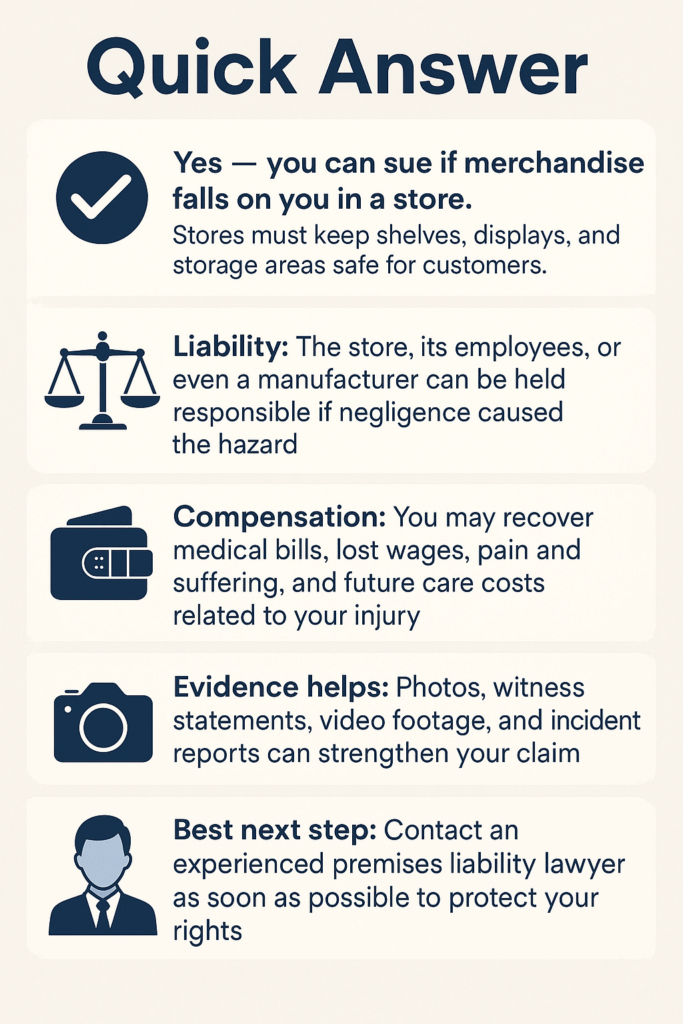
If you were injured by falling merchandise, you may have the right to file a premises liability claim. Shopping should be safe, but sometimes accidents happen. One common hazard in big stores, warehouses, and grocery chains is falling merchandise. Heavy boxes can drop from high shelves, unstable displays can collapse, and poorly stacked items can shift without warning.
For customers, these accidents can cause serious injuries such as head trauma, broken bones, or lasting pain that requires medical care and time away from work. When a store fails to keep storage areas safe, it may be held responsible. Many shoppers each year are injured by falling merchandise, and studies from the National Safety Council highlight how improper stacking and unsafe shelving contribute to retail accidents nationwide.
This article explains how merchandise accidents happen, who may be liable, and what compensation an injured shopper may recover.

Customers injured by falling merchandise in warehouse-style retailers often face head or back injuries when heavy boxes collapse. According to OSHA, employers are required to follow safe storage standards to prevent these hazards. Falling merchandise accidents typically occur due to several common hazardous conditions that stores should actively prevent:
Accidents happen when employees pile items too high or stack them unsafely to save space. This creates unstable shelves that can collapse without warning, especially in warehouse-style stores.
Shelving that isn’t anchored, racks that can’t hold enough weight, or temporary displays without support can tip or spill merchandise onto customers.
Placing bulky or heavy goods on top shelves without proper support makes them more likely to fall and injure shoppers.
If items are stored too high to reach safely or aisles are too narrow, customers may be forced to stretch or pull merchandise, which can cause falls.
There isn’t a fixed amount. The value of your claim depends on the seriousness of your injuries, how long recovery takes, and what proof you have about what happened.
Compensation may cover:
Victims injured by falling merchandise may also qualify for compensation if the incident leads to permanent disability or emotional trauma. The CDC notes that falls are one of the leading causes of traumatic brain injuries in the U.S. The more serious the injury, the higher the potential claim. Strong evidence, such as medical records, witness statements, and proof that the store was unsafe, will strengthen your case.

Liability can fall on more than one party, depending on what or who caused the merchandise to fall. It can be the:
The main responsibility lies with the business. Owners and operators must keep the store safe by following proper stocking practices, using safe shelving, and inspecting regularly.
Sometimes the hazard comes from workers. An employee who stacks items incorrectly, skips safety steps, or leaves merchandise unsecured may share responsibility.
Not all dangers are caused by store practices. If a shelf or display was poorly designed, made with defects, or installed incorrectly, the company that supplied it may also be liable.
If shelving units are poorly designed, customers injured by falling merchandise may also have a product liability claim against the manufacturer. Legal guides such as Nolo explain how liability can extend beyond just the store owner.
To hold a store accountable, you need to show that its negligence created the dangerous situation that caused your injuries. This usually comes down to proving three key points:
There must have been an unsafe condition, like unstable stacks, overloaded shelves, or storage that violated safety rules. A reasonable operator would have recognized this as unsafe.
You’ll need to show that the hazard wasn’t hidden. Prior accidents, customer complaints, or employees noticing the issue can prove knowledge. Stores can also be held responsible if they skipped inspections that would have revealed the danger.
Once aware of a hazard, the store must fix it. Ignoring complaints, neglecting inspections, or refusing to enforce safe stocking procedures are all signs of failure.
Evidence such as surveillance video, incident reports, witness accounts, and maintenance records can help prove the store was negligent.
So, can you sue if you were injured by falling merchandise? It depends on the facts, but if a store failed to follow safe practices and you were harmed, you may have the right to seek compensation.
Thompson Law has experience with premises liability cases, including unsafe shelving and merchandise accidents. Our team investigates, gathers the evidence needed to prove negligence, and pursues the recovery you deserve.
If you or a loved one were hurt by falling merchandise in a store, reach out today. Contact Thompson Law for a FREE CONSULTATION and let our team review your case at no cost to you.

Serving clients in:
Yes. If the store’s negligence — such as unsafe stacking, unstable shelving, or poor maintenance — caused merchandise to fall and injure you, you may have a premises liability claim.
The store owner or operator is usually responsible for keeping the premises safe. In some cases, employees, maintenance contractors, or even manufacturers of faulty shelves or displays may share liability.
Strong evidence includes photos or videos of the scene, witness statements, store incident reports, surveillance footage, and medical records documenting your injuries.
You may seek compensation for medical expenses, lost income, pain and suffering, rehabilitation costs, and future medical care if your injuries require long-term treatment.
Yes — a lawyer can gather evidence, prove negligence, and negotiate with the store’s insurance company to get fair compensation. Most attorneys, including Thompson Law, work on a contingency fee basis, meaning you pay nothing unless they win your case.
If you are injured by falling merchandise, seek immediate medical care, report the incident to store management, and gather evidence such as photos or witness statements. This helps protect your rights and strengthens your claim.
Each state has a statute of limitations, often two years from the date of injury. Filing early helps preserve evidence and gives your attorney time to build a strong case.
Sí. Hablamos español. We provide bilingual support so Spanish-speaking clients have full access to our attorneys.
Contact Thompson Law for a FREE CONSULTATION






Thompson Law charges NO FEE unless we obtain a settlement for your case. We’ve put over $1.9 billion in cash settlements in our clients’ pockets. Contact us today for a free, no-obligation consultation to discuss your accident, get your questions answered, and understand your legal options.
State law limits the time you have to file a claim after an injury accident, so call today.